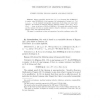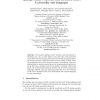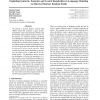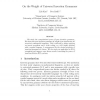84 search results - page 3 / 17 » Efficient Enumeration of Regular Languages |
IPL
2006
13 years 8 months ago
2006
In this paper we investigate P systems whose compartments contain sets of symbolobjects rather than multisets of objects, as it is common in membrane computing. If the number of m...
ECCC
2008
13 years 8 months ago
2008
Higman essentially showed that if A is any language then SUBSEQ(A) is regular, where SUBSEQ(A) is the language of all subsequences of strings in A. Let s1, s2, s3, . . . be the sta...
NC
2008
13 years 8 months ago
2008
We consider spiking neural P systems with rules allowed to introduce zero, one, or more spikes at the same time. The motivation comes both from constructing small universal systems...
ICML
2005
IEEE
14 years 9 months ago
2005
IEEE
We present a directed Markov random field (MRF) model that combines n-gram models, probabilistic context free grammars (PCFGs) and probabilistic latent semantic analysis (PLSA) fo...
TCS
2008
13 years 8 months ago
2008
We study the computational power of pure insertion grammars. We show that pure insertion grammars of weight 3 can characterize all recursively enumerable languages. This is achiev...




